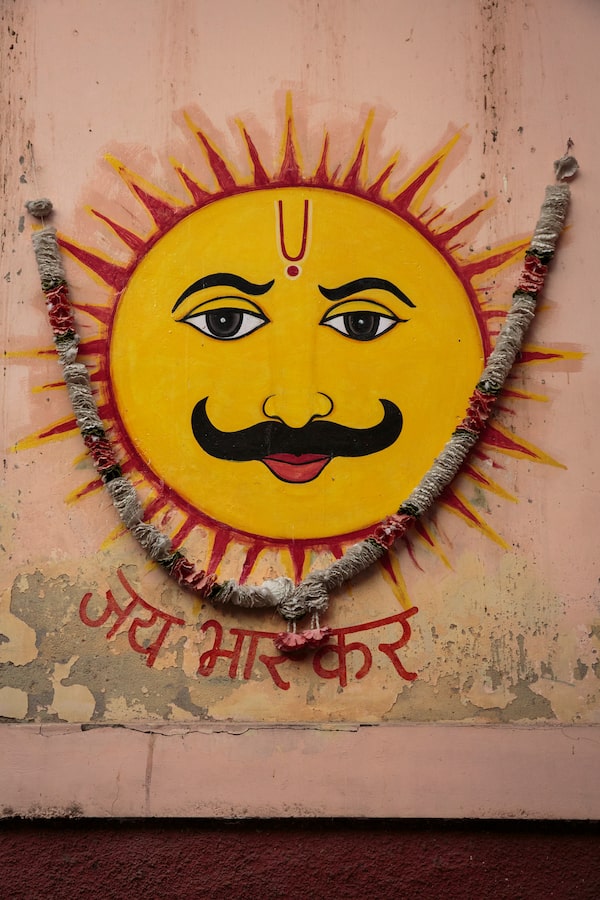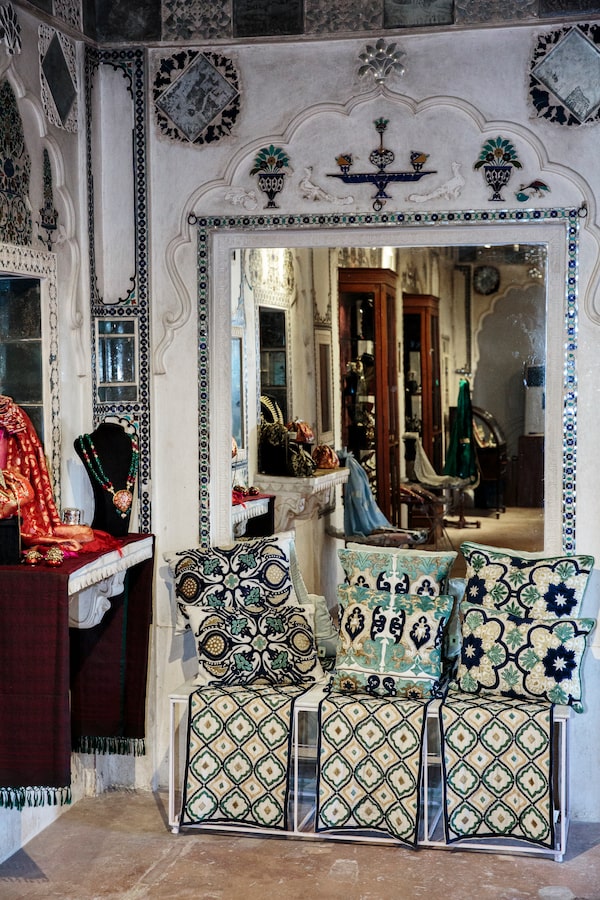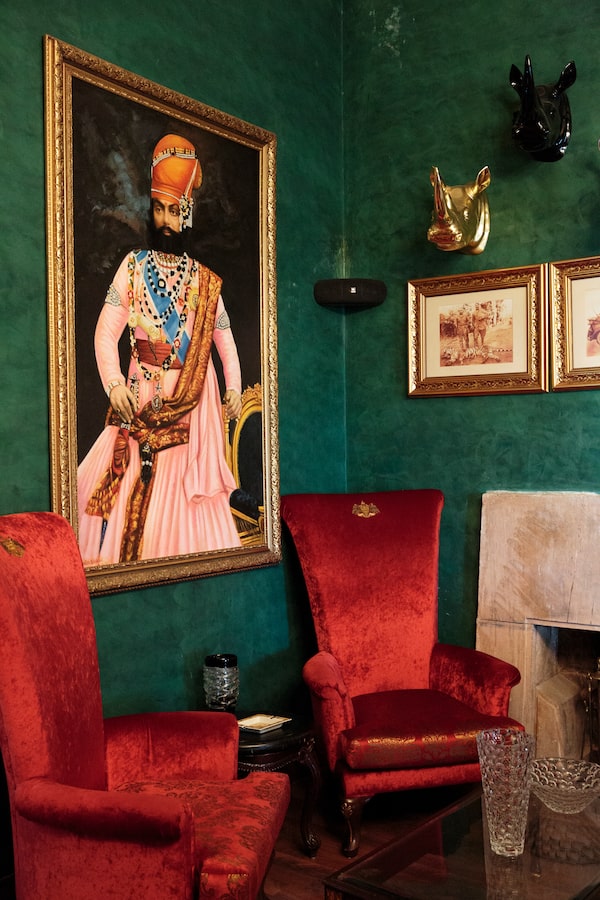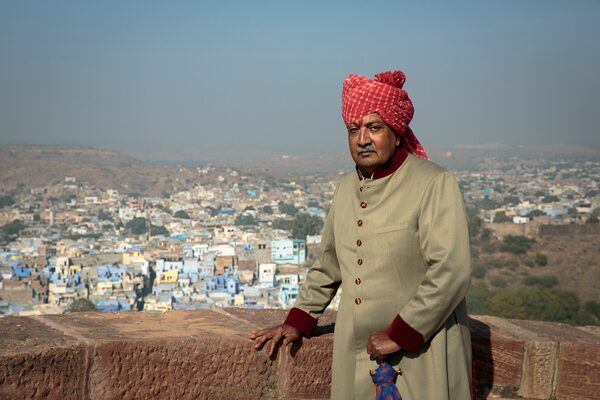
The sun sets over the old city on Jan. 6, 2019 in Jodhpur, India. Jodhpur is known as the blue city and is located in the Thar Desert of Rajasthan.Sara Hylton
At the centre of Jodhpur, India, is a big rocky outcropping with the Mehrangarh Fort perched on top. You can see it from anywhere in the city. Up close, marks reveal where stonemasons carved out the hill to build the structure. The site contains palaces and temples and was the place where the Jodhpur royal family lived from the late 1400s until the early 20th century. Today, it’s a museum, home to many objects that will be on display in the Treasures of a Desert Kingdom exhibition, a new show about Rajasthan’s art and decorative objects that I’m the co-ordinating curator for at the Royal Ontario Museum in Toronto.

A blue home in the old city on Jan. 7, 2019 in Jodhpur, India.Sara Hylton
The exhibition, which opens March 9, includes paintings, jewellery, textiles and opulent objects from the collection of a dynasty that ruled over the Kingdom of Marwar within Rajasthan until India’s independence in 1947. Jodhpur has a sense of living history. Similarly, museum exhibitions are doorways to a new place. They offer you fresh ways of thinking about the things you see while travelling, so that you don’t have to rely on stereotypes perpetuated in popular culture. They provide a taste of what’s possible abroad, and prepare you in surprising ways for new experiences.

A man drinks chai outside of a barber shop in the old city on Jan. 7, 2019 in Jodhpur, India.Sara Hylton
One of the main things that strikes me in Jodhpur is the sun. It has such a different quality there than in other parts of India, or anywhere else in the world, for that matter. It is just so much larger, like a ball of fire in the sky. But rather than feeling oppressive, it has an uplifting effect and gives off a unique quality of light, intensifying the local colours – of flowers, of the local clothing and of the painted house fronts. Jodhpur is known as the Blue City because of a mixture of limestone and copper sulfate in the whitewash used to paint the houses, which look like a cubist painting from a distance.

A sun motif painted in the old city on Jan. 6, 2019 in Jodhpur, India.Sara Hylton
When I learned about the art and architecture of Jodhpur, it completely made sense to me that the sun features as a major motif. It is everywhere, and often personified as a mustached Rajput warrior. Jodhpur royalty trace their lineage to the Hindu sun god, Surya. The sun motif comes through frequently in the exhibition, which starts off with a spectacular jewelled shield in the shape of the sun. But the main thrust of the show is to understand how this remote desert kingdom, against the odds, became a powerful and cosmopolitan force in the region.

Goods for sale at the shop in Mehrangarh Fort on January 7, 2019 in Jodhpur, India.Sara Hylton
Women played an important role in this growth. Instead of being seen as passive subjects hidden behind a veil in the dark recesses of the palace, women were the main agents of cross-cultural exchange. Through marriage, women from other courts came to Jodhpur with an entourage and brought new ideas, new languages and cuisine, and new forms of art. They were active participants at court, had independent sources of income, participated in sports, hunting and battle, organized the festivities at important holidays and influenced politics. One of my favourite paintings in the exhibition shows the head queen sitting in formation with the many other queens and princesses around her in the courtyard of the women’s space, called a zenana. You can still visit these spaces in the old palace in Jodhpur today.

A woman poses for a portait in the zenana room in Mehrangarh Fort on Jan. 7, 2019 in Jodhpur, India.Sara Hylton

Women walk through the zenana space at Mehrangarh Fort on Jan. 7, 2019 in Jodhpur, India.Sara Hylton

People shop at Sadar Market, near the Ghanta Ghar clock tower on Jan. 6, 2019 in Jodhpur, India.Sara Hylton

A view of Jaswant Thada on Jan. 7, 2019 in Jodhpur, India. The structure was built by Maharaja Sardar Singh in 1899, and is the cremation ground for the royal family.Sara Hylton/SARA HYLTON
The Umaid Bhawan Palace was built in the early 20th century. It is where the Jodhpur royal family lives today, but half of it has been turned into a luxury hotel, Taj Umaid Bhawan Palace Jodhpur, so visitors can literally stay where royalty walked – and still walks – the halls. More people know about this palace now because actor Priyanka Chopra and musician Nick Jonas married there in a glitzy wedding at the end of 2018.

The pool area at Umaid Bhawan Palace on Jan. 8, 2019 in Jodhpur, IndiaSara Hylton
It is a remarkable structure because it was built in the art-deco style, and is known as the largest art-deco building in the world. I love the architectural details that are a fusion of Western and Indian aesthetics, like deco doors with elephant-head handles. The palace reflects a time when Indian royalty became part of the global elite, hiring the best architects and designers. While much of the Western world was struggling through the Great Depression, Indian royalty kept European luxury brands like Rolls-Royce and Cartier afloat by commissioning custom products. The exhibition will feature a few of these, including a Rolls-Royce custom-made for the Jodhpur maharaja, complete with tinted windows and sidelights so that the ladies of the palace could go hunting at night.

The entrance at Mehrangarh Fort on Jan. 7, 2019 in Jodhpur, India.Sara Hylton
There are also lots of quaint smaller structures around Jodhpur that connect to royal history. Hanwant Mahal is a royal hunting lodge that’s been turned into a restaurant with great views of Umaid Bhawan. My favourite, though, is Jaswant Thada, the memorial and cenotaph dedicated to the royal ancestors. The central building is made of white marble and contains photographs and paintings of past maharajas.

Interiors of Hanwant Mahal on Jan. 8, 2019 in Jodhpur, India.Sara Hylton
Jodhpur was particularly well-known for its stunning paintings that captured scenes of life at court, or religious and mythological subjects. You can still find workshops of traditional painters in the city, but the highest-quality work can be found at the shop within Mehrangarh Fort. I love the amazing paintings with intricate detail, so much so that I bought one for the ROM’s collection as an example of contemporary Jodhpur painting using traditional techniques. Supporting artists is one way the current royal family still enriches the region, maintaining the spirit of openness and collaboration that made it into the rich destination it is today. – As told to Andrew Sardone

An employee at Umaid Bhawan Palace poses for a portrait in the spa of the Maharani suite on Jan. 8, 2019 in Jodhpur, IndiaSara Hylton

Maharaja Gaj Singh poses for a portrait on his birthday at Chamunda Mata temple on Jan. 8, 2019 in Jodhpur, India.Sara Hylton
Deepali Dewan is the Dan Mishra Curator of South Asian Art and Culture at the Royal Ontario Museum in Toronto.
On Location
HANWANT MAHAL
Once the location of a royal hunting lodge, this restaurant offers a mix of fine Indian cuisine with unrivalled views over the city.
MEHRANGARH FORT
This complex includes the Jaswant Thada cenotaph, palaces, temples and a museum with a boutique selling contemporary examples of local art and crafts.
Admission for international guests is 600 rupees (approximately $11) through mehrangarh.org.
TAJ UMAID BHAWAN PALACE JODHPUR
Still home to the royal family, who live in the world’s sixth-largest private residence, Taj Hotels’ Jodhpur property includes a museum dedicated to the dynasty and a palm court fashioned from the same marble as the Taj Mahal.
Room rates start at 28,500 rupees (approximately $525) through tajhotels.com.
Air Canada, Air India, Jet Airways and their partners all connect to Jodhpur from Canadian airports. Treasures of a Desert Kingdom: The Royal Arts of Jodhpur, India, continues at Toronto’s Royal Ontario Museum until Sept. 2. For more information, visit rom.on.ca.

Sunset at Umaid Bhawan Palace on Jan. 8, 2019 in Jodhpur, IndiaSara Hylton



